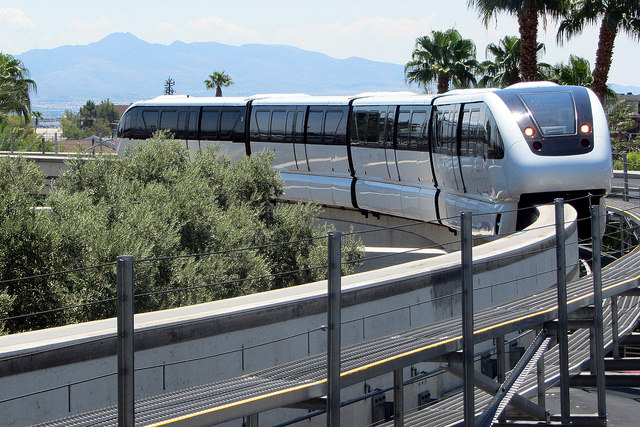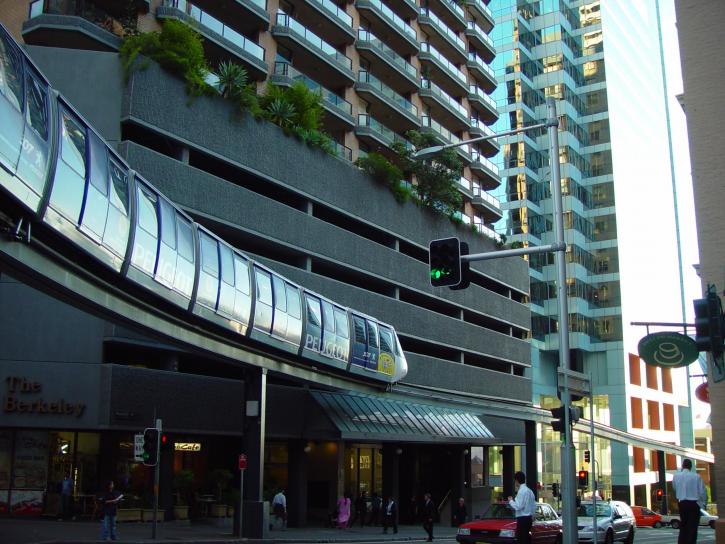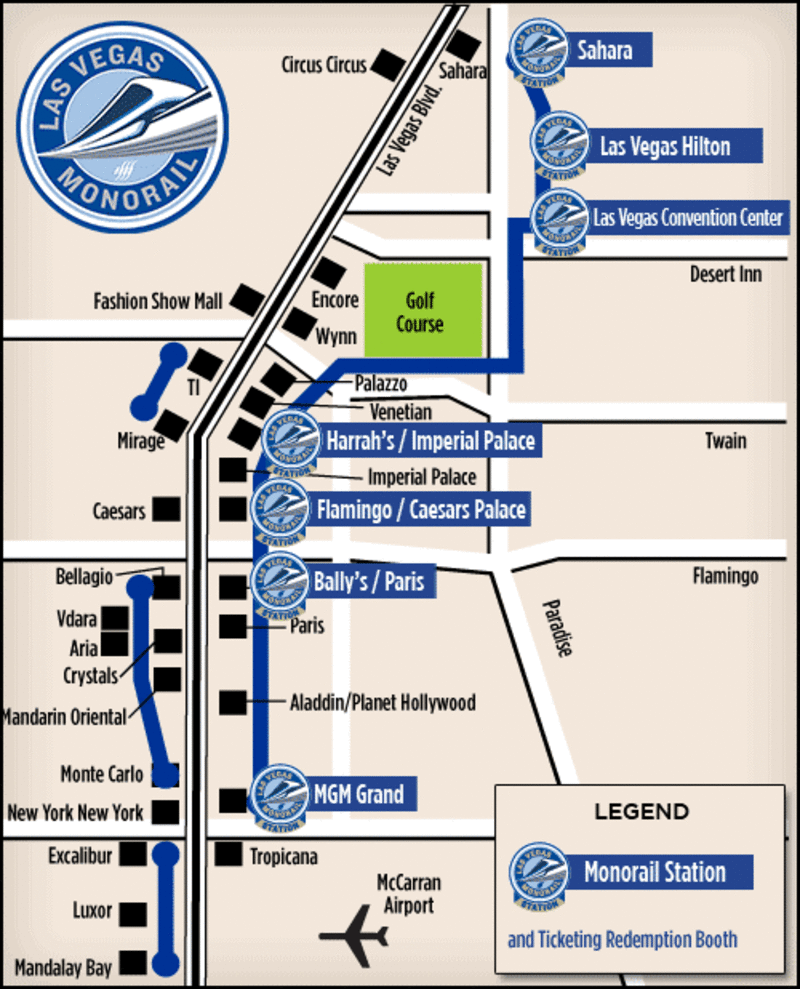The Las Vegas Monorail has a single line that operates between seven stations along a 6.3 km route. It was inaugurated in 2004. It commences operations at 7 in the morning and, depending on the day of the week, closes at midnight, 2 a.m. or 3 a.m. A single fare ticket costs $5.00 USD, but there are a variety of daily passes with unlimited rides. There is no direct connection with the airport.
Transit systems in the United States: Las Vegas Monorail
Famous for its casinos, nightlife and gambling, Las Vegas is one of the most visited metropolis within the United States, both by nationals and tourists from abroad. There are about 1.9 million people living in its metropolitan area. Despite not being that large relative to the biggest cities in the US, ‘fabulous’ Las Vegas receives about 40 million visitors each year. Even though the city has an extreme climate, as it is in the middle of the Nevada desert, tourists continue to travel to it, and the number is only on the rise.
It is considered by many as the world’s entertainment capital, and has many 5-star hotels, bars, casinos, aquatic parks, and many other complexes for leisure and entertainment. With such a large number of visitors, the city needed a public transport system that could handle the rising demand for movement. A solution was conceived, and in 2004, Las Vegas Monorail opened its doors. It operates on The Strip, south of downtown Las Vegas, allowing for easy and convenient transport in that area.
This new mass transit system was plagued with problems and setbacks at the start of the project, and led to temporary closures. One of the gravest problems was the unforeseen detachment of parts of the trains while they were on the move. Objects that then fell onto the floor where vehicles and people transit.
The monorail had only been operational for 2 months when the first temporary closure occurred due to this. It restarted operations on December of that same year. However, it had to close again in February due to problems with the electrical supply. This issue had no lasting importance, though, and was resolved quickly. Two years later, it commenced normal operations and even managed to be profitable, despite having a very short length (6.3 km).
Lines and stations
The monorail has only one line that runs for 6.3 km from the former Sahara Hotel and Casino complex (now replaced by the SLS Hotel & Casino Las Vegas) in the Winchester neighborhood to the south of the well-known Las Vegas Boulevard. It has seven stations. It is a rather small system, small for a mass public transport, anyway. There is a project for its expansion, however. It would see the addition of 5 new stations connecting the city centre and the airport.
About 13,500 people use the monorail each day. It travels at a top operating speed of 80 km/h (on a short segment), and all trains have a very high-quality standard. Each train is composed of four wagons. The transport is comfortable and secure, allowing its users a refuge from the suffocating heat of Las Vegas.
 Monorail View Image via Loozrboy
.
Monorail View Image via Loozrboy
.
Stations
SLS Station: this station was conceived as a means to reconcile the historical Sahara Hotel & Casino (now closed) with the numerous modern constructions around it. It is located within the SLS Las Vegas Resort, an entertainment complex with restaurants run by international chefs, shops, luxury bazaars, pools and about 1,300 rooms distributed in a large area (about 30,000 m²).
Westgate Station: it is located in the Westgate Las Vegas Resort & Casino complex, a place known for Elvis Presley’s shows. ‘The King’ gave 837 sold-out concerts in this hotel (back then named International Hotel). It has themed rooms, game centers, restaurants and periodic events to showcase popular artists.
Convention Center Station: located in the building of the same name, it has direct access to the convention complex, where many events and presentations are held on a weekly basis. As a special feature, when there is a massive event in this place, the monorail increases the frequency of the trains, serving it every 4 minutes.
Harrah’s & The LINQ Station: the station is located in front of Harrah’s Las Vegas, the LINQ Hotel and Casino and the LINQ Promenade. Here, passengers may exit to enjoy the many amenities around: restaurants, bars, shops. The Brooklyn Bowl is accessible from here, a place dedicated to artistic performances with over 78,000 square meters of space available. Another attraction is the High Roller observation wheel, that offers panoramic views of the city.
Flamingo & Caesars Palace Station: this station is located right in the heart of the city, between the Flamingo Hotel, an oasis where many artists perform, and the Caesars Palace, one of the most famous and luxurious hotels in the city. Passengers have direct access to the many restaurants, shops and nocturnal life. This could be a good choice for a stay, as the hotel has about 3,560 rooms available.
Bally’s & Paris Station: this is located between the Paris Las Vegas and Bally’s hotels. The romantic charm of the ‘city of light’ along with the Eiffel tower replica take its visitors for a tour on the Old Continent. In the Paris Las Vegas Hotel, the French architecture is evident, inviting the passengers to descend and explore all its Parisian beauty in the same place, with thematic restaurants, shops, casinos and replicas of famous structures.
MGM Grand Station: The south terminal of the system is located at the MGM Grand Las Vegas. This iconic and very well-known hotel boasts an impressive 5,000 rooms and many entertainment options and events, everything from music, sports, thematic parties are hosted here. Ideal place for the tourists that want to truly experience Las Vegas, without giving up comfort and luxury.
Timetables and schedule
The trains operate every day, but their working hours vary according to the day and to demand. It normally runs with the following schedule:
- Monday: open from 7:00 a.m. to midnight. This is the least busy day of the week.
- Tuesday to Thursday: running from 7:00 a.m. to 2:00 a.m.
- Friday to Sunday: available from 7:00 a.m. to 3:00 a.m.
Trains arrive at the stations every 4 to 8 minutes, depending on user demand. In certain special events, some stations may be prioritized over the others in order to increase efficiency.
Pricing
The cost for a single ticket on the monorail is $5.00 USD. Tickets may be bought at ticket vending machines (TVMs) located near the entrance of all stations, at the Customer Service Ticketing Offices, distributed around the system or online. Ticketing Offices are not limited to selling tickets, however, as they are operated by a specialized team that focuses on giving the passenger a great experience. The will kindly answer any doubts or concerns anyone could have, and offer assistance or guidance to whoever may need it. They offer directions and references to guide the passenger to whatever destination the may have. All offices allow credit or debit cards, as well as cash.
 Monoriel Imagen via Public domain
.
Monoriel Imagen via Public domain
.
One point mentioning about this system, though. Refunds are not normally authorized except for specific situations once the ticket has been purchased, so any problems in that area must be resolved via an online assistance procedure that is available through their webpage.
Location of the Customer Service Ticketing Offices: not every station in the system has a Service Office. The ones that do are located in the following stations, and are available from 10:00 am to 6:00 pm:
Bally’s & Paris Station Flamingo & Caesars Palace Station Harrah’s & The LINQ Station Westgate Station SLS Station
In the MGM Grand Station there is no office, but it does have a customer service ticket desk within the properties, and users may cancel tickets regardless of their payment option. Harrah’s & The LINQ Station also has this service. They are the only two stations in this system with this service. They are both open from 9:00 am to 7:00 pm from Sunday to Thursday, and Friday and Saturday they are open from 9:00 am to 9:00 pm.
Types of tickets
Apart from the single ticket, officially called Single Ride Ticket that costs $5.00, the company in charge of running the system offers many other fares intended mainly for tourism:
- One-day pass: it allows the holder to use the service for an unlimited amount of times within a 24-hour period. It costs $12.00.
- Two-day pass: for $22.00 USD, travelers may use the system without limit for an entire 48 hours.
- Three-day pass: it covers 72 hours of unlimited travel in the monorail. It can be bought for $28.00.
- Four-day pass: as with all the other tickets above, this pass allows the user to travel all the times they want within a 96-hour period, at a price of $36.00 USD.
- Five-day pass: it allows for 120 hours of unlimited travel, at a cost of $43.00.
- Seven-day pass: for $56.00 USD, a 168-hour unlimited travel pass is available.
Users may occasionally receive special offers, discounts or free tickets as gifts from affiliate shops and corporations that benefit from the monorail. There is also a special discounted fee for Nevada residents.
Vending machines
Las Vegas Monorail has TVMs (ticket vending machines) on all its stations, as well as in several of the hotel and entertainment complexes it serves. They all have touch screens with a very natural and intuitive interface that is directed towards making the purchase process easy and quick. The vending machines accept cash, credit and debit cards. In case the user decides to pay in cash, the machine is limited in the amount of change it can return, as it must not exceed $20.00 USD (it returns $1.00 USD coins).
Users may also acquire their tickets in several other ways, apart from the TVMs: via the Customer Service Ticketing Offices; buying them online as digital tickets or directly from some hotel and venue receptions. Online tickets may vary slightly if the user has discount codes.
Regulations
Prohibitions
- Smoking is not allowed within the installations or trains.
- Users may not enter the cabin of the train driver.
- Users may not enter restricted areas reserved for personnel, train operators or machinery.
- Begging is not allowed within the stations or trains.
- Footwear is essential to access the facilities.
- People who are under the effects of alcohol or illicit substances may be evicted from the system, as well as receive a fine from the city authorities.
- Passengers may not distract the personnel while they are performing their duties.
- Deadly or dangerous objects are not allowed in the stations or trains.
- Oversized items that cause problems for other passengers are forbidden from entering the system.
- Passengers may only occupy one seat in the monorail. Other seats must not be taken by luggage, bags or any other item.
- Personal music devices are allowed only if the user is wearing headphones.
- It is prohibited to assault in any way, harass, intimidate or otherwise threaten any other user of the system.
- Emergency devices may only be used in real situations.
- Unauthorized leaflets and propaganda may not be distributed within the facilities.
- It is strictly forbidden to throw any type of object onto the tracks of the monorail.
Precautions
- Passengers may remain behind the yellow line at all times, until the train has come to a complete stop.
- In order to make boarding and disembark more agile, users are advised to stand at the sides of the trains doors while on the platform, and not in front.
- It is recommended to anticipate the train stop for your own convenience when descending from the wagons.
- Avoid leaning on train doors.
- Avoid obstructing the closure of doors, as they may cause injuries.
Security
All stations in the system have security personnel that is specially trained to respond in emergency situations. However, they are also prepared to provide the necessary advice to passengers in any topic related to the monorail, such as vending machines, destinations, tourist attractions and general information. They will also aid anyone with a disability that needs help.
Additionally, all trains and stations are equipped with phone lines connected directly to the control central, as a means to notify immediately any emergency situation. They are located just to the side of the trains doors in the monorail, and are distributed throughout different areas of the stations. It is only necessary to lift the phone up and personnel will attend the call. Do not doubt in using them if an emergency occurs.
As an extra layer of security, the monorail has special canine units specifically trained to detect explosives or other substances. If there is any suspicious activity or package, they may be deployed to guarantee the safety of the users.
Future expansions
There are two main expansion projects intended for the monorail. The first one was designed to reach downtown Las Vegas with an expansion of 3.7 km to the northeast and four new stations: one in Stratosphere Hotel, one on the Charleston Blvd., another on Bonneville Av., and another on Main Street. The idea was originally conceived and developed in 2005, and construction was intended to start in 2008. However, the project did not receive federal funding and was subsequently archived.
Another more recent expansion project was proposed. It would see the monorail increase its length to the south, connecting it with the McCarran International Airport. However, this proposal has met heavy resistance from limousine and taxi drivers, as trips to and from the airport are a major part of their business. On the other hand, hotels and casinos have backed this project from the start, as it would make it more convenient for their customers.
In the year 2008, the company running the monorail presented the details of the project, taking advantage of an ongoing expansion of the airport. It was intended for the new segment of the system to be completed in 2012, the same year the works on the airport would be compete, but in 2011, the expansion project was still on planning stages. In 2015, local authorities revealed that a public transport Master Plan was being developed. One of the projects considered is a new underground light rail train that would run under the Strip, connecting the International Airport and the city centre. As of current development plans, both systems would be independent from each other and would operate as complementary services.
Fun facts and recommendations
All stations are named or refer to the closest major hotel they serve. Some of them are actually inside hotel grounds.
Animals are not allowed inside the facilities, so passengers must take this into account if they are travelling with their pets.
When there are big events on the Strip, the monorail can get crowded, as it handles about 67,000 daily passengers (five times more than a normal day). About the equivalent of 22,000 taxi rides.
Each train can carry 222 passengers, 72 seated and 150 in standing room.
All trains are completely electrical, so It does not directly contribute to harmful emissions.
Actual air pollution levels on the Strip have dropped since the monorail started operations, as people prefer to use it rather than other vehicles.
Each monorail train is composed of 4 wagons and has 48 wheels (8 load tires and 32 guide tires, 4 steering tires, 4 lateral support tires).
Connection with the airport
There is no direct connection between the McCarran International and the Las Vegas Monorail. However, complementary transports bridge the gap quite easily. Many people take advantage of the monorail by riding from the northernmost station to the MGM Grand Station at the south. From there, they take a taxi to the airport. This way, they can save some money on the taxi fare, as the distance is greatly reduced.
The same is true when travelling into the city from McCarran. One must take a taxi, but you can reach MGM Grand Station and save some money while enjoying the views of the city the monorail offers, as it rides about 18 m above the ground on the highest point (9 m average).
Las Vegas Monorail map
- Also Known As: Monorail
- Passengers/Day 22893
- Fares:
- 24h operation: No
- Air Conditioning: No
- Walk between platforms: No
- Driverless trains: Monorail (since 2004)
- Screen Doors Platforms: Yes
- Operator: Las Vegas Monorail Company
- $5.00
- Las Vegas Metro Official Website
- Tlf: +1 702 699 8200
Help us
If you consider that the information we provide is wrong, not accurated, outdated, translation contains errors, and you would like to help us to improve the file...you can contact us here.
Feel free to contact us if you dont find the system you're looking for and we'll add it as soon as we can!
Thank you very much!











